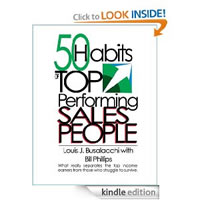50 Habits of Top Performing Sales People: Habit #3 – The 90 Day Calendar
 September 19, 2014
September 19, 2014
 Selling
Selling
 Comments Off on 50 Habits of Top Performing Sales People: Habit #3 – The 90 Day Calendar
Comments Off on 50 Habits of Top Performing Sales People: Habit #3 – The 90 Day Calendar
Continuing with the twelve Organizational Skills let's look at Habit #3 - The 90 Day Calendar: Plan a business and travel calendar 90 days in advance. Habit 3 takes time management to another level by taking the focus on time from Habits 1 and 2 and using it to plan the salespersons business and travel calendar 90 days into the future. The goal is to provide focus to the salespersons schedule so they are doing the right thing at the right time to maximize their sales effort. Creating a 90 Day Calendar is one of the main things we do ...

50 Habits of Top Performing Sales People: Habit #2 – The First Thing Each Day
 September 18, 2014
September 18, 2014
 Selling
Selling
 Comments Off on 50 Habits of Top Performing Sales People: Habit #2 – The First Thing Each Day
Comments Off on 50 Habits of Top Performing Sales People: Habit #2 – The First Thing Each Day
Continuing with the twelve Organizational Skills let's look at Habit #2 - The First Thing Each Day: The first function of each day is to review a daily calendar and decide which tasks you will do and move tasks that will not be done that day to another day. Habit 1 is about task development to maximize time invested daily, weekly and monthly and Habit 2 continues the focus on time management by defining what tasks are done each day with the hours available.Sales people are typically aggressive in nature and often have large tasks lists that contain more "things" than ...

50 Habits of Top Performing Sales People: Habit #1 – Time for Tasks
 July 16, 2014
July 16, 2014
 Selling
Selling
 Comments Off on 50 Habits of Top Performing Sales People: Habit #1 – Time for Tasks
Comments Off on 50 Habits of Top Performing Sales People: Habit #1 – Time for Tasks
By Bill Phillips, Strategen, Inc. Starting with the twelve Organizational Skills, let's look at Habit 1 - Time for Tasks: Top Performers plan time each day to do specific tasks. The day is divided into segments dedicated to tasks such as follows: follow-up calls, quoting, trip planning, calendar development, account plan development and other daily tasks. Time management is at the core of performance for Top Performers. They understand how valuable their time is to themselves, their company and their customers. As defined in our book, a salesperson selling $3 million a year working ten hour days has revenues of $1200 per hour ...

50 Habits of Top Performing Sales People
This month we turn our focus to a topic at the core of our business, developing and driving proactive sales organizations and sales people. We understand that Top Performing sales people are critical components to a sales organization and in our book, "50 Habits of Top Performing Sales People" we cover the skills required for Top Performing sales people. We know Top Performers are not born. We also know that with training and mentoring, we can develop Top Performing sales people if they have the desire and discipline to be Top Performers. We state in our book, "The 50 Habits are ...

Tying Employee Performance to the Strategic Plan (Part 7)
By Bill Phillips, Strategen, Inc. The Strategic Plan is a tool that should be used to improve the operation of the business. The newsletters from the past several months have discussed three steps involved in tying employee performance to the Strategic Plan. Each is a key component to successful implementation of the strategic plan and all are equally important to the success of the Plan and the Company. STEP 1: Establish Performance Metrics The first step is establishing performance metrics that define the Key Performance Indicators (KPI's) that are drivers for the business. Management needs to establish realistic, simple and attainable metrics tied ...

Tying Employee Performance to the Strategic Plan (Part 6)
 April 30, 2014
April 30, 2014
 Strategic Planning
Strategic Planning
 Comments Off on Tying Employee Performance to the Strategic Plan (Part 6)
Comments Off on Tying Employee Performance to the Strategic Plan (Part 6)
Continuing the discussion this month with "Visual Management to Show Continuous Progress and Status”, let's look deeper into how to define and use visual management tools. The key to visual management is that it needs to be easy for people to use and the information displayed needs to drive improvements and track performance to a defined goal. Performance data is what is important and needed to drive the business and this comes full circle back to the first step, developing measurables and key performance indicators (KPI's) that really drive what you do and when managed and measured tell the truth ...

Tying Employee Performance to the Strategic Plan (Part 5)
By Bill Phillips, Strategen, Inc. Continuing the discussion; the third step of our three step process for Tying Employee Performance to the Strategic Plan is: "visual management to show continuous progress and status". To review, the three important areas for metrics in Strategic Planning are: 1) Performance metrics 2) Follow up to determine progress and status 3) Visual management tools to show continuous progress and status. Newsletters from the past several months have dealt with the first two steps in detail. Visual Management is my favorite of the three steps and can be the simplest to implement and use. It surprises me how much information ...





